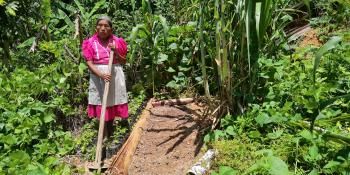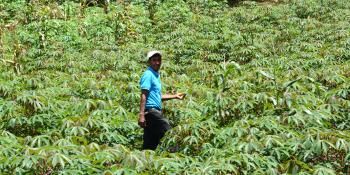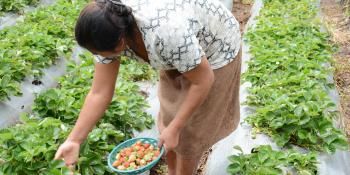Agro-climatic Digitally Integrated Solutions

Project description
The climate-smart agriculture (CSA) strategy for the Central American Integration System (SICA) contains three major areas of work around climate risk management:
- generation and exchange of agro-climatic information at a regional scale;
- timely generation and communication of climate risk management information; and
- promotion of methods and tools to assess risks and losses in the agricultural sector, also at a regional scale.
A few initiatives have taken place to implement the SICA's CSA strategy in order to have a more active role in the climate risk management component. These initiatives include the strengthening of capacities in National Meteorological Services; initial steps toward the establishment of an Central America Climate Outlook Forum (CACOF); the establishment of 10 Local Technical Agro-climatic Committees (LTACs); and the adoption of a food security decision support system by the Guatemalan Secretariat of Food and Nutritional Security (SESAN).
This project seeks to advance towards the development of a user-centered, digitally integrated and scalable system to support information generation, use and exchange among decision-makers within the SICA system. System design will follow from the synthesis of case studies and co-development with stakeholders from the regional level (Climate Outlook Forum - COF) through to the meso (LTACs) and local levels (extension services, farmers).
The system will seek to improve agro-advisory systems and food security management in Central America, strengthening institutional capacities at various levels, and ultimately increasing the resilience and food security of 300,000 farmers in the region.
Activities
- Conduct research on how to combine food security monitoring data with climate information (historical, and forecasts) at regional (COF) and national (Instituto Nacional de Sismología, Vulcanología, Meteorología e Hidrología—INSIVUMEH) scale, using a modeling approach in order to identify trigger points for early warning.
- Evaluate existing approaches (seasonal, sub-seasonal), information products and information needs of women, youth and other actors, centered on mid-summer drought forecasts, and enhance their use in agricultural decision making at the local level through the 10 existing LTACs. Support the inclusion of women’s organizations in LTACs.
- Collaborate with Flagship on Climate-Smart Technologies and Practices project on digital CSA transformation to integrate seasonal and sub-seasonal forecasts into the scaling out of digital agricultural advisory services.
- Synthesize case studies with a focus on developing a system integrating different scales (regional through to local) to facilitate the generation, translation, transfer and use of agro-climatic information for decision making.
Outputs
Journal articles
- Journal article on “Systematic approach to regional integration of climate services across sectors and scales in Central America”.
Journal article on each of the case studies:
- A case study on improving the predictability of the mid-summer drought in relation to the needs of specific sectors (agriculture, food security, and humanitarian assistance) and groups (women, youth).
- The relationship between food security and seasonal and sub-seasonal forecasts to improve early warning triggers for early, forecast-based action.
- Connecting seasonal forecasts to agricultural advisory services (in collaboration with Flagship on Climate-Smart Technologies and Practices and Digital Climate-Smart Agriculture Transformation project).
Tools
- Tool to identify and prioritize entry points for targeted interventions and improvements in information provision.
- Climate data integration toolkit/information system for SICA (CACOF, and Centro Clima) that supports the integration, exchange, generation and use of agro-climatic and food security information between different scales and sectors.
- Tool for enhanced prediction of mid-summer drought in Central America in connection to agricultural decision making.
- Food security and agricultural advisory toolkit supporting the translation of agro-climatic and food security forecasts into forecast-based actions (e.g. in terms of dietary recommendations), and into agronomic advice (e.g. crop/farm management).
Expected outcomes
- 300,000 farmers in Central America increase their resilience and food security by using digitally integrated agro-climatic and food security information for crop management and early warning. At the same time, digitally integrated climate information increases the benefits of existing agro-climatic advisory services for 50,000 women in Central America.
- 10 public and private organizations contribute to digitally integrating agro-climatic advisory services for farmers to reduce climate risk and increase food security based on CCAFS science and tools.
- 4 women-focused farmer organizations provide digitally integrated and gender-sensitive climate services to their farmers. These women-focused farmer organizations would be recruited by 4 agro-climatic committees to be part of the co-production, translation, transfer, and use of climate services for agriculture and food security.
- At least 3 policy decisions by organizations of the SICA and/or the national ministries of agriculture in Central America are partly influenced by our work on digitally integrated solutions for climate risk and food security management.
Read more
- Approach: Local Technical Agroclimatic Committees (LTACs)
- Guide: Technical Agroclimatic Committees (MTA): A detailed guide for implementing MTA, step-by-step
- Video: Local Technical Agroclimatic Committees-Putting tailored climate information in the hands of farmers
- Brief: Digital solutions for managing climate risks and food security in Guatemala
- Brochure: Putting Climate Information in the Hands of Farmers
- Journal article: A systematic approach to assess climate information products applied to agriculture and food security in Guatemala and Colombia
- Journal article: Emergency drills for agricultural drought response: A case study in Guatemala


